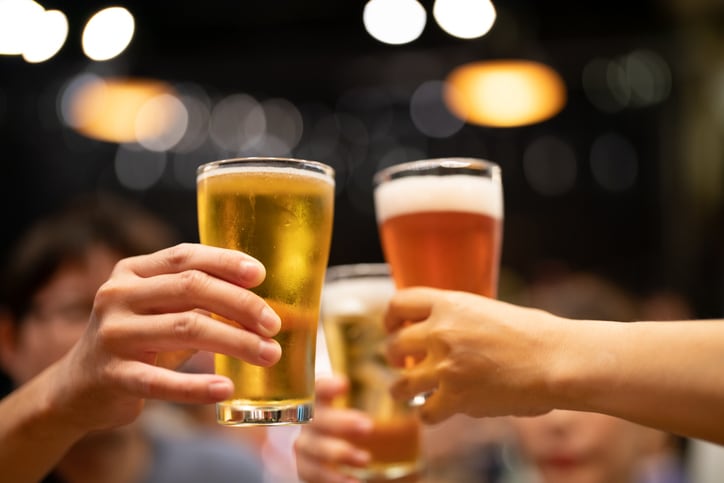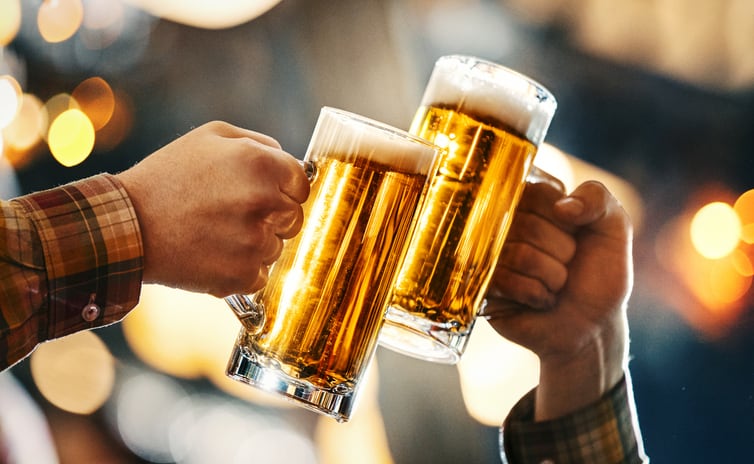While there’s no global standard for the definition of ‘alcohol-free’, most countries accept 0.5% ABV as the rule.
The exception is the UK: which currently defines alcohol-free as a much stricter 0.05%.
The country has been dabbling with the idea of raising this threshold for many years, but no action has been taken.
But now it looks like the question is back on the agenda...
Consultation, consultation and consultation
The UK has been spearheading the modern alcohol-free movement: with the category consistently growing and more and more innovation emerging.
Volumes of alcohol-free drinks are projected to grow at a CAGR of 7% between 2024-2028, according to IWSR: far, far above growth rates for alcohol drinks.
But many in the industry argue that the UK’s definition of alcohol-free has been standing in the way of even further growth.
In 2018, the UK government ran a consultation into low alcohol descriptors. In 2023, another consultation was run. And now, in July 2025, a new consultation has been promised.
“As we tackle harmful levels of alcohol consumption, we want to support innovation in new product categories and support businesses that sell them to thrive,” announces the UK government in its 10 Year Health Plan for England, published earlier this month.
“In the past 10 years, there has been significant growth in the no and low (NoLo) alcohol market. To support further growth, we will consult on changing the upper strength threshold at which a drink may be described as alcohol free to 0.5% ABV, which will bring it into alignment with international standards.”
Strong support
Alcohol is naturally present in tiny quantities across many foods and beverages. A ripe banana, for example, can contain up to 0.4% ABV.
According to a study from the University of Frieberg, a person drinking 1.5 liters of 0.5% beer over the course of an hour will see no physiological effects (the average human liver processes the alcohol in a 330ml 0.5% beer in less than 10 minutes).
And what’s most important to UK brands is that a move to 0.5% ABV would create a level playing field for British brands on a global scale.
And 0.5% ABV would also help encourage innovation among smaller brewers. Creating a decent alcohol-free beer is no mean feat to start with: brewing to 0.5% is less technically challenging than brewing to 0.05%, partly because much less equipment is required.
Another quirk is that 0.5% ABV would also align alcohol-free beers with the UK’s own duty rules (which eliminate beers with less than 0.5% from alcohol duty).
A market ready for further growth
Alcohol-free beer has been the real winner in the UK market. With technological leaps and bounds having already been made across Europe over the last decades, the UK was quick to adopt the category and make it its own.

And no alcohol beer is driving growth in low/no: the category grew 20% in 2024 compared to 2023, according to IWSR.
It’s here the difference between 0.05% and 0.5% could make a big difference. Many beers are brewed to 0.5%: essentially removing any alcohol that would give an ‘effect’ but still contributing to body and flavor.
And with alcohol-free beers leading the UK’s moderation scene and being the most established and developed brands, they’re also the ones that are expanding internationally... but facing confusing differences between 0.05% and 0.5% regulations.
UK alcohol-free market growth
Volumes of the total no alcohol market are expected to grow at a CAGR of 7% between 2024 and 2028.
No-alcohol beer grew 20% in 2024 vs 2023. Alcohol-free spirits, while slowing a little, still grew 7%. Alcohol-free wine grew 8%, against total wine category declines.
Source: IWSR
Ready for action?
While some might be frustrated at the time it’s taken to address the question, campaigners for 0.5% ABV are just happy to hear the topic is still on the government’s radar, although as yet there is no date as to when the new consultation will run.
The last consultation in 2023 was overtaken by the 2024 General Election, meaning that the question will be considered by a different government.
The Portman Group, the industry’s self-regulator backed by giants including Diageo, Bacardi, Brown-Forman, Heineken, Suntory and Molson Coors (alongside domestic alcohol-free beer innovator Lucky Saint), says changing the regulations is important for any brands doing business on a global scale.
“We welcome the government explicitly considering our longstanding position to raise the alcohol-free threshold to 0.5% ABV in line with international peers,” said Chief Executive Matt Lambert. “We look forward to restating the case to help clear up consumer confusion, as we did under the previous Government in 2018 and 2023, using the latest evidence available.”
Chris Hannaway, founder of the UK’s Infinite Session, is optimistic that raising the threshold to 0.5% will be well-supported.
“I’m happy this is back on the agenda and hopefully gets it done quickly and smoothly,” he said.
“The findings of the last consultation seemed positive (just without the decisive action) and it now seems they’re ready to take that action and support innovation in no and low.”
Many industry groups, including the Portman Group and moderation movement Club Soda, support a move to 0.5%. And to many consumers, the difference between 0.5% and 0.05% is negligible.
However, the consultation will also want to hear views from people who may find that distinction important and consider any volume of alcohol, however small, significant (for some, serving a 0.5% alcohol drink, is ‘a bit like giving a vegetarian a salad with some thinly cut ham’).
That might be important, for example, for consumers who choose not to drink for religious reasons; or might make another personal choice to abstain from alcohol entirely and completely.
And at the end of the day, something all stakeholders can agree on is transparency. Clear labeling on products give consumers the right to make their own choices according to their own beliefs, culture and personal considerations.



